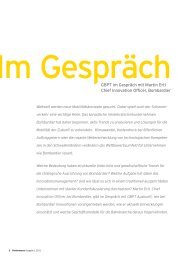PERF RMANCE 04 - The Performance Portal - Ernst & Young
PERF RMANCE 04 - The Performance Portal - Ernst & Young
PERF RMANCE 04 - The Performance Portal - Ernst & Young
You also want an ePaper? Increase the reach of your titles
YUMPU automatically turns print PDFs into web optimized ePapers that Google loves.
<strong>The</strong> new era of community<br />
value<br />
Connecting many thousands of<br />
geographically dispersed global employees<br />
can seem daunting. However, two trends<br />
ease the difficulty of this task: the first<br />
is the rise in self-organized behavior of<br />
individuals within the enterprise, and<br />
the second is the development of nextgeneration,<br />
social-enabled communities<br />
which achieve connections and bridge<br />
white space.<br />
<strong>The</strong> dramatic and continuing rise in usage<br />
of the social web across all demographic<br />
groups has increased the everyday<br />
employee’s familiarity with transparent,<br />
interactive online behavior, leading to<br />
an equally dramatic change in cultural<br />
behaviors both outside and within the walls<br />
of most organizations. As a direct impact of<br />
this trend, employees have<br />
become increasingly comfortable<br />
knowing, and sharing, more about<br />
themselves and each other, setting the<br />
stage for increased connectivity.<br />
Rather than looking to discourage these<br />
connections, leading organizations are<br />
harnessing this trend by channeling the<br />
desire for connection into value-producing<br />
communities. <strong>The</strong>se communities may<br />
have many purposes — improving technical<br />
competency, problem-solving, innovation,<br />
customer or partner relationships, or<br />
affinity groups, to name a few — but<br />
perhaps just as crucially, they serve the<br />
vital purpose of segmenting an enterprise<br />
of thousands of people into smaller, more<br />
human-sized units (Dunbar, 1993).<br />
Well-functioning communities are crucial<br />
for the formation of well-functioning<br />
ties. <strong>The</strong>y can provide a mechanism for<br />
“ <strong>The</strong>se communities serve the vital<br />
purpose of segmenting an enterprise<br />
of thousands of people into smaller,<br />
more human-sized units.”<br />
employees to build up social capital,<br />
form personal networks based on shared<br />
interests and experiences, and develop<br />
trust with one other. Engaged and vibrant<br />
communities can quicken time-to-value for<br />
new employees and become an incentive<br />
for them to remain, while also serving<br />
as a vehicle for capturing and retaining<br />
the knowledge of employees leaving the<br />
organization — creating greater cultural<br />
durability in good times and bad. <strong>The</strong>se<br />
communities can become the keepers of<br />
intellectual capital, continually refreshing,<br />
refining and extending it over time — as well<br />
as archiving it via a process that satisfies<br />
shifting compliance requirements. <strong>The</strong>y can<br />
create a channel for employees to provide<br />
value, as well as a channel for recognition<br />
of that value in a compelling and credible<br />
context — and at the scale and level that has<br />
maximum impact on the individual.<br />
Communities can also promote innovation.<br />
Once formed, many of these communities<br />
can — through a combination of active<br />
management, competency development,<br />
training and engagement programs —<br />
be effectively transformed into small<br />
startups within the enterprise. Generation<br />
and harvesting of pioneering ideas from<br />
within and across these “intrapreneurial“<br />
communities can provide crucial<br />
differentiation in crowded product and<br />
capital markets. And coordinated correctly,<br />
this small office culture can be distributed<br />
among employees who then feel loyalty to<br />
the same set of organizational priorities —<br />
no matter where in the world they may sit.<br />
For these communities to flourish and<br />
provide differential value, they must<br />
be explicitly sponsored, appropriately<br />
resourced, and actively managed (see<br />
Figure 1 and 2).<br />
For enterprise executives looking to the<br />
future, the skills used in managing and<br />
driving internal communities to create<br />
value can directly translate into market<br />
differentiation. Strong and weak ties<br />
already span the boundaries between<br />
suppliers, partners and customers — they<br />
are not, however, being invested in at a<br />
rate or level that equals their potential<br />
value. This is especially true with external<br />
engagement for those enterprises with<br />
historic legacies and flagship brands.<br />
By investing in strong community<br />
management skills today, executives<br />
can take a first step toward developing<br />
talented mangers for tomorrow’s<br />
external communities.






